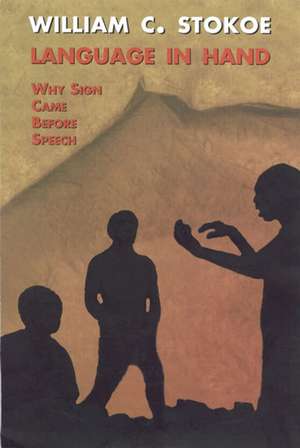Language in Hand: Why Sign Came Before Speech
Autor William C. Stokoeen Limba Engleză Hardback – 18 iun 2001
Stokoe recounts in Language in Hand how inspiration grew out of his original discovery in the 1950s and ’60s that deaf people who signed were using a true language with constructions that did not derive from spoken English. This erudite, highly engaging investigation calls upon decades of personal experience and published research to refute the recently entrenched principles that humans have a special, innate learning faculty for language and that speech equates with language. Integrating current findings in linguistics, semiotics, and anthropology, Stokoe fashions a closely-reasoned argument that suggests how our human ancestors’ powers of observation and natural hand movements could have evolved into signed morphemes.
Stokoe also proposes how the primarily gestural expression of language with vocal support shifted to primarily vocal language with gestural accompaniment. When describing this transition, however, he never loses sight of the significance of humans in the natural world and the role of environmental stimuli in the development of language. Stokoe illustrates this contention with fascinating observations of small, contemporary ethnic groups such as the Assiniboin Nakotas, a Native American group from Montana that intermingle their spoken and signed languages depending upon cultural imperatives.
Language in Hand also presents innovative thoughts on classifiers in American Sign Language and their similarity to certain spoken languages, convincing evidence that speech originally copied sign language forms before developing unrelated conventions through usage. Stokoe concludes with a hypothesis on how the acceptance of sign language as the first language of humans could revolutionize the education of infants, both deaf and hearing, who, like early humans, have the full capacity for language without speech.
Preț: 297.05 lei
Preț vechi: 313.03 lei
-5% Nou
Puncte Express: 446
Preț estimativ în valută:
56.86€ • 61.78$ • 47.79£
56.86€ • 61.78$ • 47.79£
Carte tipărită la comandă
Livrare economică 18-29 aprilie
Preluare comenzi: 021 569.72.76
Specificații
ISBN-13: 9781563681035
ISBN-10: 156368103X
Pagini: 232
Ilustrații: illustrations
Dimensiuni: 152 x 229 x 23 mm
Greutate: 0.6 kg
Ediția:First Edition
Editura: Gallaudet University Press
Colecția Gallaudet University Press
ISBN-10: 156368103X
Pagini: 232
Ilustrații: illustrations
Dimensiuni: 152 x 229 x 23 mm
Greutate: 0.6 kg
Ediția:First Edition
Editura: Gallaudet University Press
Colecția Gallaudet University Press
Notă biografică
William C. Stokoe was Professor Emeritus at Gallaudet University and the founding editor of Sign Language Studies.
